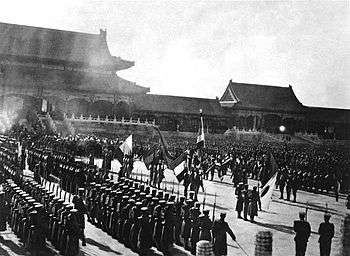Eight-Nation Alliance
| Eight-Nation Alliance | |||||||
| Traditional Chinese | 八國聯軍 | ||||||
|---|---|---|---|---|---|---|---|
| Simplified Chinese | 八国联军 | ||||||
| |||||||
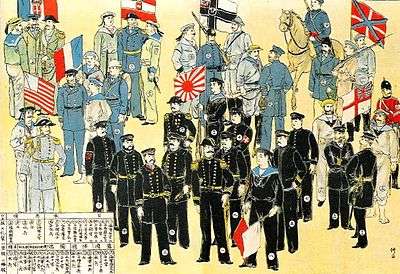

The Eight-Nation Alliance was an "international" military coalition set up in response to the Boxer Rebellion in China. The eight nations were Japan, Russia, Britain, France, the United States, Germany, Italy and Austria-Hungary.[1] In the summer of 1900, when the international legations in Beijing were besieged by Boxer rebels supported by the Qing government, the coalition dispatched their armed forces, in the name of humanitarian intervention, to defend their respective nations' citizens, as well as a number of Chinese Christians who had taken shelter in the legations. The incident ended with a coalition victory and the signing of the Boxer Protocol.
Background and main events
The Boxers, a peasant movement, had attacked and killed foreign missionaries, nationals and Chinese Christians across northern China in 1899 and 1900. The Qing government and Imperial Army supported the Boxers and under the Manchu general Ronglu, besieged foreign diplomats and civilians taking refuge in the Legation Quarter in Peking.[2] After failing in its initial attempt to relieve the Legation Quarter, in August 1900 the Allied force marched to Peking from Tianjin, defeated the Qing Imperial Army's Wuwei Corps in several engagements, and brought an end to the Boxer Rebellion and the siege. The members of the Alliance then occupied Peking and proceeded to loot and pillage the capital.[3][4] The forces consisted of approximately 45,000 troops, from various countries. At the end of the campaign, the Qing Imperial government signed the Boxer Protocol of 1901.[5]
Siege of the International Legations and the North Cathedral

The diplomatic compound in Peking was under siege by the Wuwei Rear Division of the Chinese army and some Boxers (Yihetuan), for 55 days, from 20 June to 14 August 1900. A total of 473 foreign civilians, 409 soldiers from eight countries, and about 3,000 Chinese Christians took refuge in the Legation Quarter.[6] Under the command of the British minister to China, Claude Maxwell MacDonald, the legation staff and security personnel defended the compound with small arms and one old muzzle-loaded cannon discovered and unearthed by Chinese Christians who turned it over to the Allies; it was nicknamed the International Gun because the barrel was British, the carriage Italian, the shells Russian, and the crew American.[7]
Also under siege in Peking was the North Cathedral, the Beitang of the Catholic Church. The Beitang was defended by 43 French and Italian soldiers, 33 foreign Catholic priests and nuns and about 3,200 Chinese Catholics. The defenders suffered heavy casualties from lack of food and Chinese mines that exploded in tunnels dug beneath the compound.[8]
Member nations
| Forces of the Eight-Nation Alliance Relief of the Legations 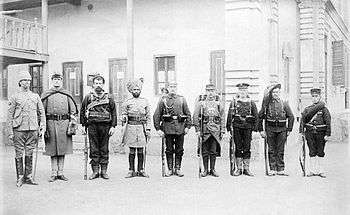 Left to right: Britain, United States, Australia, India, Germany, France, Austria-Hungary, Italy, Japan | |||
| Countries | Warships (units) |
Marines (men) |
Army (men) |
|---|---|---|---|
| 18 | 540 | 20,300 | |
| 10 | 750 | 12,400 | |
| 8 | 2,020 | 10,000 | |
| 5 | 390 | 3,130 | |
| 2 | 295 | 3,125 | |
| 5 | 600 | 300 | |
| 2 | 80 | 2,500 | |
| 4 | 296 | unknown | |
| Total | 54 | 4,971 | 51,755 |
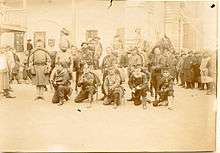
Austria-Hungary
Austria-Hungary had a single cruiser SMS Zenta on station at the beginning of the rebellion, based at the Russian concession of Port Arthur.[9] Detachments of sailors from the Zenta were the only Austro-Hungarian forces to see action.[10] Some were involved in defending the legations under siege while another detachment was involved in the rescue attempts.[10] In June, the Austro-Hungarians helped hold the Tianjin railway against Boxer forces and also fired upon several armed junks on the Hai River near Tong-Tcheou in Peking. They also took part in the seizure of the Taku Forts commanding the approaches to Tianjin, and the boarding and capture of four Chinese destroyers by Capt. Roger Keyes of HMS Fame.
The Austro-Hungarian Navy also sent the cruisers SMS Kaiserin und Königin Maria Theresia, SMS Kaiserin Elisabeth, SMS Aspern and a company of marines to China. Arriving in September, however, they were too late as most of the fighting had ended and the legations relieved. The cruisers together with the Zenta were involved in shelling and capture of several Chinese forts.[10] The Austro-Hungarians suffered minimal casualties during the rebellion. After the Boxer uprising, a cruiser was maintained permanently on the Chinese coast and a detachment of marines was deployed at the Austro-Hungarian embassy in Peking (Beijing).[10] Lieutenant Georg Ludwig von Trapp, made famous in the 1959 musical The Sound of Music, was decorated for bravery aboard SMS Kaiserin und Königin Maria Theresia during the rebellion.[11][12]
British Empire
At the outset of the Boxer Rebellion, Britain was engaged in the Boer conflict in South Africa.[13] Consequently with the army tied down by the war, the British had to rely on the China Squadron and troops largely from India. The Royal Navy's China Squadron, stationed off Tientsin, consisted of the battleships Barfleur and Centurion; the cruisers Alacrity, Algerine, Aurora, Endymion, and Orlando; and the destroyers Whiting and Fame.[14] British forces were the third-largest contingent in the international alliance, and consisted of the following units: Naval Brigade, 12th Battery Royal Field Artillery, Hong Kong & Singapore Artillery, 2nd Battalion Royal Welsh Fusiliers, 1st Bengal Lancers, 7th Rajput Infantry, 24th Punjab Infantry, 1st Sikh Infantry, Hong Kong Regiment, 1st Chinese Regiment, Royal Engineers, and other support personnel.[15][16]
Australian colonies
Australia did not become federalised and independent as a unified nation until 1901. As such several of the Australian colonies, independently of each other, sent contingents of naval and army personnel to support the British contingent. For example, South Australia sent its entire navy: the gunboat HMCS Protector.[17] Australia, therefore, was not an official member of the eight-nation alliance and its forces arrived too late to see significant action.[18]
India
Britain provided 10,000 troops, of which a large part were Indian troops, made out of units of Baluchis, Sikhs, Gurkhas, Rajputs and Punjabis.[19][20][21]
Germany
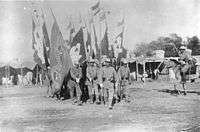
Germany had gained a presence in China after the Juye Incident in which two German missionaries were murdered in November 1897. The concession in Kiaochow, with the port of Tsingtao, was used as a naval base for the East Asia Squadron and a trading port. It was governed and garrisoned by the Imperial German Navy. At the outbreak of the Boxer Rebellion in June 1900, the garrison of the German concession comprised the III. Seebataillon with 1,126 men, a marine/naval artillery battery, about 800 men of a Kommando Detachment and sailors from the East Asian Squadron.[22]
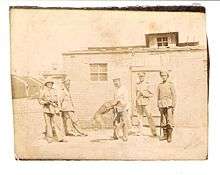
With the increasing threat of the Boxers a small group from the III. Seebatallion was sent to Peking and Tientsin to protect German interests there, while the majority of the remaining forces stayed behind to prevent attacks against Tsingtao. The siege of the foreign legations in Peking soon convinced Germany and the other European powers that more forces were needed to be sent to China to reinforce allied forces. The first troops dispatched from Germany were the Marine-Expeditionskorps which consisted of the I. and II. Seebatallions. They were soon followed by the Ostasiatische Expeditionskorps (East Asian Expeditionary Corps), which was a force of about 15,000 of mostly volunteers from the regular Army under the command of Gen Alfred Count von Waldersee. It comprised initially four and later six two-battalion infantry regiments and a Jäger company, single regiments of cavalry and field artillery and various support and logistics units.[22] On arrival in China it incorporated the Marine-Expeditionskorps that had preceded it to China by a few weeks.[22]
However, the majority of the German forces dispatched arrived too late to take part in any of the major actions;[22] the first elements of the Corps arrived at Taku on September 21[22] after the legations had been relieved. As a result most of the Corps were mainly employed for garrison duties, they did fight a number of smaller engagements against pockets of remaining Boxers.[23] The Corps was later disbanded and recalled to Germany early in 1901.[23]
France

Three battalions of marines, the II/9th, and the I and II/11th RIMa which were stationed in French Indochina were sent to China. They joined the 1st brigade of Marines commanded by general Henri-Nicolas Frey. In July 1900, the 2nd and 3rd battalions of infantry embarked from Toulon but did not reach China until September. In October, following losses and rotations of duty, the first three battalions sent were included in the 16th regiment of marines by order of general Régis Voyron, commander in chief of the French Expeditionary Corps in China. On 1 January 1901, the 16th RIMa was renamed the 16th regiment of colonial infantry. At the end of the campaign, it moved to a new base in Tianjin, with its headquarters in the former buildings of the Chinese admiralty.[24]
Italy
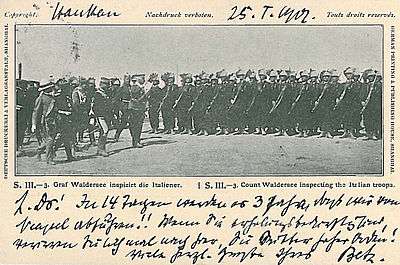
In 1898, the Italians had demanded San Mun Bay as a concession; however, the Chinese refused.[25] The Italian Navy then dispatched a squadron to San Mun Bay, but no further action was taken. The squadron remained there, and when in the summer of 1900 the Boxer Rebellion broke out, detachments from Italian cruisers were sent to Peking. Italian forces were initially made up of sailors from warships.[26] A portion of these helped the French defend the Pei Tang Catholic cathedral while another defended the European Legations in Peking during the famous fifty-five-day siege.[25] Italian sailors also took part in the attacks on the Dagu forts and in capturing Tientsin.[25] However, a larger contingent was later dispatched from Italy, including 83 officers, 1,882 troops, and 178 horses. The contingent included a battalion of Bersaglieri, which was formed from one company each from the 1st, 2nd, 4th, 5th, 6th, 8th, 9th, and 11th Bersaglieri Regiments. In addition, the 24th Line Regiment, volunteers from the Alpini, a battery of machine guns, and some engineers were also sent to China.[26] A battery of field guns was also supplied by the Italian Navy.[26] The total force of 1,965 officers and men, which composed the Italian expeditionary force against the Boxers, was officially referred to as the Italian Royal Troops in China.[25] In August 1900, when this larger force reached the capital, the Italians had seven cruisers and 2,543 men in the country. They were involved in numerous operations along the coast and in the interior of northern China.[25]
The larger part of the approximately 2,000 Italian soldiers and officers who fought in the campaign against the Boxers were recalled from Peking after the end of the conflict. Italy obtained a 151-acre concession area in Tianjin and the right to occupy the Shanhaiguan fort.[27][25] A small naval squadron and a naval garrison were maintained in China to protect Italian interests there.[25]
Japan
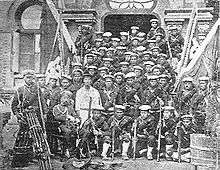
Japan provided the largest contingent of troops; 20,840, as well as 18 warships. Of the total number, 20,300 were Imperial Japanese Army troops of the 5th Infantry Division under Lt. General Yamaguchi Motoomi; the remainder were 540 naval rikusentai(Marines) from the Imperial Japanese Navy.[28]
At the beginning of the Boxer Rebellion the Japanese only had 215 troops in northern China stationed at Tientsin, nearly all of them were naval rikusentai from the Kasagi and the Atago, under the command of Captain Shimamura Hayao.[29] The Japanese were able to contribute 52 men to the Seymour Expedition.[29] On June 12, the advance of the Seymour Expedition was halted some 30 miles from the capital, by mixed Boxer and Chinese regular army forces. The vastly outnumbered allies withdrew to the vicinity of Tianjin, having suffered more than 300 casualties.[30] The army general staff in Tokyo had become aware of the worsening conditions in China and had drafted ambitious contingency plans,[31] but the government in the wake of the Triple Intervention five years prior, refused to deploy large number of troops unless requested by the western powers.[31] However three days later, a provisional force of 1,300 troops commanded by Major General Fukushima Yasumasa, was to be deployed to northern China. Fukushima was chosen because his ability to speak fluent English which enabled him to communicate with the British commander, the force landed near Tianjin on July 5.[31]
On June 17, naval Rikusentai from the Kasagi and Atago had joined British, Russian, and German sailors to seize the Dagu forts near Tianjin.[31] The British, in light of the precarious situation were compelled to ask Japan for additional reinforcements as the Japanese had the only readily available forces in the region.[31] Britain at the time was heavily engaged in the Boer War, consequently a large part of the British army was tied down in South Africa, also deploying large numbers of troops from its garrisons in India would take too much time and weaken internal security there.[31] Overriding personal doubts, Foreign Minister Aoki Shūzō calculated that the advantages of participating in an allied coalition were too attractive to ignore. Prime Minister Yamagata likewise concurred, but others in the cabinet demanded that there be guarantees from the British in return for the risks and costs of the major deployment of Japanese troops.[31] On July 6, the 5th Infantry Division was alerted for possible deployment to China, but no timetable was set for its deployment. Two days later on July 8, with more ground troops urgently needed to lift the siege of the foreign legations at Peking, the British ambassador offered the Japanese government one million British pounds in exchange for Japanese participation.[31]
Shortly afterward, advance units of the 5th Division departed for China, bringing Japanese strength to 3,800 personnel of the then 17,000 allied force.[31] The commander of the 5th Division, Lt. General Yamaguchi Motoomi had taken operational control from Fukushima. Japanese troops were involved in the storming of Tianjin on July 14,[31] after which the allies consolidated and awaited the remainder of the 5th Division and other coalition reinforcements. By that time the siege of legations was lifted on August 14, the Japanese force of 13,000 was the largest single contingent, made up about 40 percent of the approximately 33,000 strong allied expeditionary force.[31] Japanese troops involved int the fighting had acquitted themselves well, although a British military observer felt their aggressiveness, densely packed formations, and over willingness to attack cost them excessive and disproportionate casualties.[32] For example, during the Tianjin fighting, the Japanese suffered more than half of the allied casualties, 400 out of 730, but comprised less than one quarter (3,800) of the force of 17,000.[32] Similarly at Beijing, where the Japanese accounted for almost two-thirds of the losses, 280 of 453, but constituted slightly less than half of the assault force.[32]
Russia
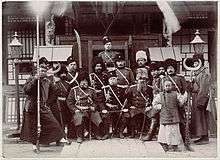
Russia supplied the second largest force after Japan, with 12,400 troops, consisting mainly of garrisons from Port Arthur and Vladivostok.[33] On 30 November 1900, Admiral Alekseyev compelled the Chinese military governor of Shenyang, Zeng Qi, to sign an agreement that effectively ended Chinese sovereignty over Manchuria and placed it under Russian control.[34]
United States

In the United States, the suppression of the Boxer Rebellion was known as the China Relief Expedition.[35] The United States was able to play a major role in suppressing the Boxer Rebellion largely due to the presence of American forces deployed in the Philippines since the US annexation after the Spanish–American War in 1898.[36] Of the foreigners under siege in Beijing, there were 56 American Sailors and Marines from the USS Oregon and USS Newark.[36] The main American formations deployed to relieve the siege were the 9th Infantry and 14th Infantry regiments, elements of the 6th Cavalry regiment, the 5th Artillery regiment, and a Marine battalion, all under the command of Adna Chaffee.[37][38] Future President Herbert Hoover and Mrs. Lou Henry Hoover were living in the foreign compound during the siege when Mr. Hoover was working for the Chinese Engineering and Mining Company. Mr. Hoover helped erect barricades and formed a protective force of the able bodied men. Mrs. Hoover helped set up a hospital, nursed the wounded, set up a dairy, took part in the night watch, took tea to sentries and carried a Mauser .38 semi-automatic pistol.[39][40]
Aftermath
Troops of the eight aforementioned nations invaded and occupied Peking on 14 August 1900. Empress Dowager Cixi, the Emperor and high government officials fled the Imperial Palace for Xi'an and sent Li Hongzhang for peace talks with the Alliance.[41]
In a research article, Kenneth Clark states: "Following the taking of Peking, troops from the international force looted the capital city and even ransacked the Forbidden City, with many Chinese treasures finding their way to Europe."[42]
Atrocities
A large number of Christians were killed by the boxers before the rebellion.[43] A group of Christians that were killed before and during the rebellion are commemorated to this day as the Holy Martyrs of China by the Orthodox[44] and Catholic churches.[45]
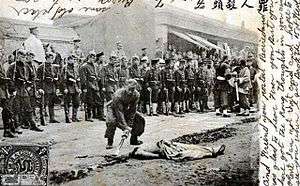
An unknown number of people believed to be Boxers were beheaded both during and after the uprising. This became the subject of an early short film.[46]
A U.S. Marine wrote that he saw German and Russian troops bayonet women after raping them.[47]
In Peking, it was alleged that Bishop Pierre-Marie-Alphonse Favier-Duperron posted a bulletin, effective 18–26 August, declaring that Catholic Christians might steal those bare necessities required to survive, and that robbery of 50 taels of silver or fewer needed neither reporting nor compensation. The accusation was denied by the Bishop.[48]
See also
| Wikimedia Commons has media related to Boxer Rebellion forces. |
References
- ↑ Hall Gardner (16 March 2016). The Failure to Prevent World War I: The Unexpected Armageddon. Routledge. p. 127. ISBN 978-1-317-03217-5.
- ↑ Grant Hayter-Menzies, Pamela Kyle Crossley (2008). Imperial masquerade: the legend of Princess Der Ling. Hong Kong University Press. p. 89. ISBN 962-209-881-9. Retrieved 2010-10-31.
- ↑ O'Conner, David The Boxer Rebellion London:Robert Hale & Company, 1973, Chap. 16. ISBN 0-7091-4780-5
- ↑ Hevia, James L. 'Looting and its discontents: Moral discourse and the plunder of Beijing, 1900–1901' in R. Bickers and R.G. Tiedemann (eds.), The Boxers, China, and the world Lanham, Maryland:Rowman & Littlefield Publishers, 2009
- ↑ Eight-Nation Alliance in Section 4 Archived 2008-12-02 at the Wayback Machine.
- ↑ Thompson, 84-85
- ↑ Benjamin R. Beede (1994). The War of 1898, and U.S. interventions, 1898–1934: an encyclopedia. Taylor & Francis. p. 50. ISBN 0-8240-5624-8. Retrieved 2010-06-28.
- ↑ Thompson, 85, 170–171
- ↑ Sondhaus 1994, p. 139.
- 1 2 3 4 Sondhaus 1994, p. 140.
- ↑ Carr 2006, p. 224.
- ↑ Bassett 2015, p. 393.
- ↑ Ion 2014, p. 37.
- ↑ Harrington 2001, p. 28.
- ↑ Bodin 1979, p. 34.
- ↑ Harrington 2001, p. 29.
- ↑ Nicholls, B., Bluejackets and Boxers
- ↑ "China (Boxer Rebellion), 1900–01". Australian War Memorial. Australian Government. Retrieved 22 January 2013.
- ↑ Krishnan, Ananth (8 July 2011). "The forgotten history of British India troops in China". The Hindu. Beijing. Retrieved 22 January 2013.
- ↑ Raugh, Harold E. (2004). The Victorians at War, 1815–1914: An Encyclopedia of British Military History. ABC-CLIO. p. 177. ISBN 978-1-57607-925-6. Retrieved 22 January 2013.
- ↑ Lee Lanning, Colonel Michael (2007). Mercenaries: Soldiers of Fortune, from Ancient Greece to Today#s Private Military Companies. Random House Digital, Inc. p. 105. ISBN 978-0-307-41604-9. Retrieved 22 December 2013.
- 1 2 3 4 5 de Quesada & Dale 2013, p. 23.
- 1 2 de Quesada & Dale 2013, p. 24.
- ↑ "Insignes des Troupes Françaises en Chine". www.symboles-et-traditions.fr. Retrieved 2 September 2017.
- 1 2 3 4 5 6 7 Paoletti 2008, p. 280.
- 1 2 3 Bodin 1979, p. 29.
- ↑ Shirley Ann Smith (8 March 2012). Imperial Designs: Italians in China 1900–1947. Lexington Books. p. 19. ISBN 978-1-61147-502-9.
- ↑ Grant McLachlan (11 November 2012). Sparrow, A Chronicle of Defiance: The story of The Sparrows. Klaut. p. 571. ISBN 978-0-473-22623-7.
- 1 2 Ion 2014, p. 44.
- ↑ Drea 2009, p. 97.
- 1 2 3 4 5 6 7 8 9 10 11 Drea 2009, p. 98.
- 1 2 3 Drea 2009, p. 99.
- ↑ To the Harbin Station: The Liberal Alternative in Russian Manchuria, 1898–1914. Stanford University Press. p. 67. ISBN 978-0-8047-6405-6.
- ↑ G. Patrick March (1996). Eastern Destiny: Russia in Asia and the North Pacific. Greenwood Publishing Group. p. 171. ISBN 978-0-275-95566-3.
- ↑ "Documents of the Boxer Rebellion (China Relief Expedition), 1900–1901". Naval History & Heritage Command. United States Navy. 13 March 2000. Archived from the original on 2 February 2013. Retrieved 22 January 2013.
- 1 2 "The Boxer Rebellion and the U.S. Navy, 1900–1901". U.S. Naval History & Heritage Command. Archived from the original on 2 January 2013. Retrieved 20 January 2013.
- ↑ "U.S. Army Campaigns: China Relief Expedition". United States Army Center of Military History. United States Army. 19 November 2010. Retrieved 22 January 2013.
- ↑ Plante, Trevor K. (1999). "U.S. Marines in the Boxer Rebellion". Prologue Magazine. United States National Archive. 31 (4). Retrieved 22 January 2013.
- ↑ Beck Young, Nancy (2004). Lou Henry Hoover: Activist First Lady. Lawrence, Kansas 66049: University Press of Kansas. pp. 15–16. ISBN 0-7006-1357-9.
- ↑ Boller, Paul F., Jr. (1988). Presidential Wives. New York, New York: Oxford University Press. pp. 271–273. ISBN 0-19-505976-X.
- ↑ Michael Dillon (December 2016). Encyclopedia of Chinese History. Taylor & Francis. p. 124. ISBN 978-1-317-81716-1.
- ↑ Kenneth G. Clark THE BOXER UPRISING 1899–1900. Russo-Japanese War Research Society
- ↑ Gordon H. Chang (13 March 2015). Fateful Ties: A History of America's Preoccupation with China. Harvard University Press. p. 88. ISBN 978-0-674-05039-6.
- ↑ James Flath; Norman Smith (13 April 2011). Beyond Suffering: Recounting War in Modern China. UBC Press. p. 231. ISBN 978-0-7748-1958-9.
- ↑ Cindy Yik-yi Chu (16 October 2012). The Catholic Church in China: 1978 to the Present. Palgrave Macmillan. pp. 86–88. ISBN 978-1-137-07565-9.
- ↑ Beheading a Chinese Boxer at IMDB
- ↑ Robert B. Edgerton (1997). Warriors of the rising sun: a history of the Japanese military. W.W. Norton & Company. p. 80. ISBN 0-393-04085-2. Retrieved 25 April 2011.
Several U.S. Marines, hardly squeamish men, were so sickened by what they saw that they violently restrained some of their more rapacious German allies, leaving at least one wounded.
- ↑ 《遣使会年鉴》 1902, page 229-230
Books
- Bassett, Richard (2015). For God and Kaiser: The Imperial Austrian Army, 1619–1918. Yale University Press. ISBN 0-300-17858-1.
- Bodin, Lynn (1979). The Boxer Rebellion. Chris Warner (illustrator). Bloomsbury Publishing. ISBN 0-85045-335-6.
- Carr, Charmian (2006). Forever Liesl: My the Sound of Music Story. Pan Books. ISBN 0-330-45100-6.
- Drea, Edward J. (2009). Japan's Imperial Army: Its Rise and Fall, 1853–1945. Lawrence, Kansas: University Press of Kansas. ISBN 0-8032-1708-0.
- de Quesada, Alejandro; Dale, Chris (2013). Imperial German Colonial and Overseas Troops 1885–1918. Bloomsbury Publishing. ISBN 1-78096-165-0.
- Harrington, Peter (2001). Peking 1900: The Boxer Rebellion. Oxford: Osprey. ISBN 1-84176-181-8.
- Ion, Hamish (2014). "The Idea of Naval Imperialism: The China Squadron and the Boxer Uprising". British Naval Strategy East of Suez, 1900–2000: Influences and Actions. Routledge. ISBN 1-135-76967-2.
- Paoletti, Ciro (2008). A Military History of Italy (illustrated ed.). Greenwood Publishing Group. ISBN 0-275-98505-9.
- Smith, Shirley Ann (2012). Imperial Designs: Italians in China 1900–1947 (illustrated ed.). Lexington Books. ISBN 1-61147-502-3.
- Sondhaus, Lawrence (1994). The Naval Policy of Austria-Hungary, 1867–1918: Navalism, Industrial Development, and the Politics of Dualism. Purdue University Press. ISBN 1-55753-034-3.
- Thompson, Larry Clinton. William Scott Ament and the Boxer Rebellion. Jefferson, NC: McFarland, 2009.
